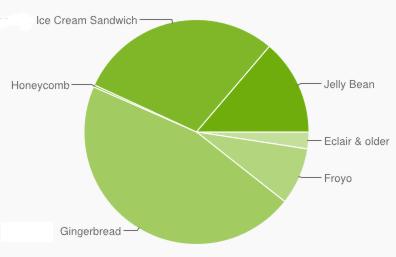| A Major Shift in the Android Landscape? |
| Written by Janet Swift | |||||||||||||||||||||||||||||||||||||||||||||||||||||||||||||
| Thursday, 04 April 2013 | |||||||||||||||||||||||||||||||||||||||||||||||||||||||||||||
|
Google has changed the basis on which it measures Android version use. As a result there's a jump in Jelly Bean's share of the Android platform. Is this a better version of reality? Google reports figures for Android use on a fortnightly basis and this frequency means that we perceive steady trends rather than sudden changes. However, starting with the latest set of charts and tables on the Android Platform Versions page of the Android developer site, Google is basing its statistics on device data collected when users visit the Google Play Store whereas previously, the data was collected when the device simply checked-in to Google servers. Google states: We believe the new data more accurately reflects those users who are most engaged in the Android and Google Play ecosystem. Let's compare the latest chart to the one from two months ago:
Period ending April 2, 2013
Period ending February 4, 2013
The noticeable differences are that in the top chart Jelly's Bean share has expanded and Froyo's and Gingerbread's have shrunk.
Let's look at the percentage differences:
Jelly Bean's share has increased by 12.4% which is equivalent to almost doubling. It now seems to have 25% of the Android platform - which means it is one one in four devices. Gingerbread's has reduced by 5.8% but is is still almost 40% - i.e. on 2 in 5 devices. Froyo's share has more than halved going from 8.1% to only 4% - i.e. on only 2 in 50 devices. This might be a better representation of the active user base on the other hand it might be skewed by the novelty factor - new users have devices that don't have any apps on them so they visit Google play more often in order to acquire them. What is important is that the changes in the above table haven't happened in a period of 8 weeks. The landscape hasn't really changed that much - it's just the new way of looking at it that makes it seem a discontinuous change.
More InformationRelated ArticlesJelly Bean On Over 10% of Androids Jelly Bean Makes Promising Progress Shift in the Android Landscape A Smoother Android - Jelly Bean (4.1) The Programmer's Take
To be informed about new articles on I Programmer, install the I Programmer Toolbar, subscribe to the RSS feed, follow us on, Twitter, Facebook, Google+ or Linkedin, or sign up for our weekly newsletter.
Comments
or email your comment to: comments@i-programmer.info
|
|||||||||||||||||||||||||||||||||||||||||||||||||||||||||||||
| Last Updated ( Thursday, 04 April 2013 ) |




